
Alyxia is an Australasian genus of flowering plant in the dogbane family, Apocynaceae. It contains at present 106 species, but Alyxia stellata and A. tisserantii are very variable, might be cryptic species complexes, and are need of further study. It consists of shrubby, climbing or scrambling plants. This genus occurs in China, the Himalayas, Southeast Asia, Malaysia, Australia, New Caledonia and the Pacific Islands. There are 14 species in Australia, 21 in New Caledonia and 7 in the other Pacific Islands, including Hawaiʻi.

Cordyline is a genus of about 15 species of woody monocotyledonous flowering plants in family Asparagaceae, subfamily Lomandroideae. The subfamily has previously been treated as a separate family Laxmanniaceae, or Lomandraceae. Other authors have placed the genus in the Agavaceae. Cordyline is native to the western Pacific Ocean region, from New Zealand, eastern Australia, southeastern Asia and Polynesia, with one species found in southeastern South America.
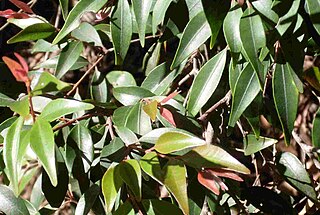
Uromyrtus is a genus of plants in the myrtle family Myrtaceae described as a genus in 1941. The greatest diversity of species are found in New Caledonia and the remainder are found in Australia, New Guinea and Borneo.
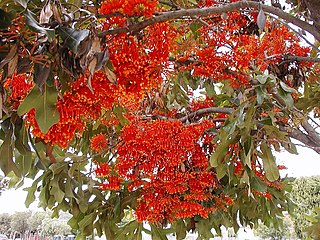
Stenocarpus is a genus of about 22 species of flowering plants in the family Proteaceae. They are trees or shrubs with variably-shaped leaves, zygomorphic, bisexual flowers, the floral tube opening on the lower side before separating into four parts, followed by fruit that is usually a narrow oblong or cylindrical follicle.

Corybas, commonly known as helmet orchids, is a genus of about 120 species of plants in the orchid family, Orchidaceae. Helmet orchids are small, perennial, deciduous herbs and are nearly always terrestrial. They have a single leaf at their base and a single flower on a short stalk, the flower dominated by its large dorsal sepal and labellum. Species of Corybas are found in Australia, New Zealand, New Guinea, Southeast Asia, the Himalayas, southern China, many Pacific islands and a few sub-Antarctic islands.
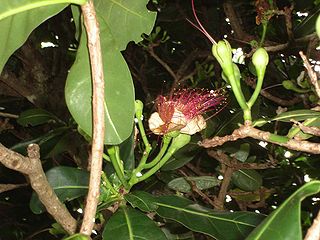
Barringtonia is a genus of flowering plants in the family Lecythidaceae first described as a genus with this name in 1775. It is native to Africa, southern Asia, Australia, and various islands of the Pacific and Indian Oceans. The genus name commemorates Daines Barrington.

Spiraeanthemum is a genus of trees and shrubs in the family Cunoniaceae. it includes about 19 species from Australia, New Guinea, Solomon Islands, New Caledonia, Vanuatu, Fiji and Samoa. Leaves are simple, opposite or whorled, with toothed or entire margins. Inflorescences are paniculate, flowers unisexual or hermaphrodite, and the fruits are follicular with free carpels. It belongs to the tribe Spiraeanthemeae, and now includes the species formerly placed in Acsmithia.
Pseuderia is a genus of orchids consisting of about 20 species distributed from the Moluccas through New Guinea to Samoa, Fiji and Micronesia. The genus has its center of diversity in New Guinea.

Tropidia, commonly known as crown orchids, is a genus of about thirty species of evergreen terrestrial orchids in the family Orchidaceae. They have thin, wiry stems with two or more tough, pleated leaves with a flowering spike at the top of the stem, bearing crowded flowers. Species in this genus are distributed across the warmer parts of both the Eastern and Western Hemispheres.

Sarcochilus, commonly known as butterfly orchids or fairy bells is a genus of about twenty species of flowering plants in the orchid family, Orchidaceae. Most species are epiphytes but a few species only grow on rocks or in leaf litter. Orchids in this genus usually have short stems, leaves arranged in two rows and flowers arranged along unbranched flowering stems. Most species are endemic to Australia but some are found in New Guinea and New Caledonia.

Polyosma is a genus of about 60 species of trees native to south-east Asia. They occur from China south through south-east Asia to the east coast of Australia, New Guinea, the Solomon Islands and New Caledonia.
Gunnarella is a genus of flowering plants from the orchid family, Orchidaceae. It and another orchid genus, Seidenfadenia, are named for Danish botanist Gunnar Seidenfaden. It contains 10 known species, native to New Guinea, New Caledonia and to other nearby islands in the Pacific.
- Gunnarella aymardii(N.Hallé) Senghas - New Caledonia
- Gunnarella begaudii(N.Hallé) Senghas - New Caledonia
- Gunnarella brigittae(N.Hallé) Senghas - New Caledonia
- Gunnarella carinata(J.J.Sm.) Senghas - New Guinea
- Gunnarella florenciae(N.Hallé) Senghas - New Caledonia
- Gunnarella gracilis(Schltr.) Senghas - New Guinea
- Gunnarella laxa(Schltr.) Senghas - Papua New Guinea to Solomon Islands
- Gunnarella nambanaB.A.Lewis - Vanuatu
- Gunnarella neocaledonica(Rendle) Senghas - New Caledonia
- Gunnarella robertsii(Schltr.) Senghas - New Caledonia, New Guinea, Vanuatu, Solomon Islands
Hymenorchis is a genus of flowering plants from the orchid family, Orchidaceae. It is native to Malaysia, Indonesia, Philippines, New Guinea and New Caledonia.
- Hymenorchis brassiiOrmerod - Papua New Guinea
- Hymenorchis caulinaSchltr. - New Guinea
- Hymenorchis foliosaSchltr. - New Guinea
- Hymenorchis glomeroidesJ.J.Sm. - New Guinea
- Hymenorchis javanica(Teijsm. & Binn.) Schltr. - Pahang, Java
- Hymenorchis kaniensisSchltr. - New Guinea
- Hymenorchis nannodesSchltr. - New Guinea
- Hymenorchis saccataSchltr. - New Guinea
- Hymenorchis serrataSchltr. - New Guinea
- Hymenorchis serrulata(N.Hallé) Garay - New Caledonia
- Hymenorchis taniiSchuit. & de Vogel - Papua New Guinea
- Hymenorchis vanoverberghii(Ames) Garay - Philippines

Peristylus, sometimes commonly known as ogre orchids or bog orchids is a genus of flowering plants from the orchid family, Orchidaceae. It consists of over 100 known species found across much of eastern and southern Asia as well as in Australia and on many islands of the Indian and Pacific Oceans.
Platylepis is a genus of flowering plants from the orchid family, Orchidaceae. It is widespread across sub-Saharan Africa and also on various islands of the Pacific and Indian Oceans.
- Platylepis bigibbosaH.Perrier - Madagascar
- Platylepis bombusJ.J.Sm. - Seram
- Platylepis commelynae(Lindl.) Rchb.f. - Society Islands
- Platylepis constricta(J.J.Sm.) J.J.Sm. - New Guinea
- Platylepis densifloraRolfe - Réunion
- Platylepis geluana(Schltr.) Schuit. & de Vogel - New Guinea
- Platylepis glandulosa(Lindl.) Rchb.f. - widespread across tropical and southern Africa
- Platylepis grandiflora(Schltr.) Ormerod - New Caledonia, Vanuatu, Futuna
- Platylepis heteromorphaRchb.f. - Samoa
- Platylepis intricataSchuit. & de Vogel - Papua New Guinea
- Platylepis lamellataSchltr. - New Guinea
- Platylepis margaritiferaSchltr. - Madagascar
- Platylepis occulta(Thouars) Rchb.f. - Madagascar, Réunion, Mauritius, Seychelles
- Platylepis polyadeniaRchb.f. - Madagascar, Comoros
- Platylepis rufa(Frapp.) Schltr. - Réunion
- Platylepis tidorensisJ.J.Sm. - Maluku
- Platylepis viscosa(Rchb.f.) Schltr. - Réunion
- Platylepis xerosteleOrmerod - Cameroon
- Platylepis zeuxinoidesSchltr. - New Guinea
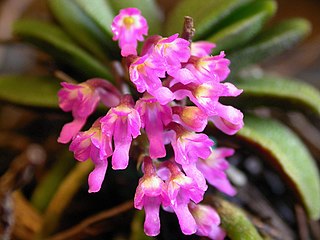
Schoenorchis, commonly known as flea orchids, or 匙唇兰属 , is a genus of flowering plants from the orchid family, Orchidaceae. Plants in this genus are small epiphytes with thin roots, thin leafy stems with leaves in two ranks and tiny fragrant, almost tube-shaped flowers with a prominently spurred labellum. There are about twenty five species found from tropical and subtropical Asia to the Western Pacific.

Sciaphila is a genus of mycoheterotrophic plants in the family Triuridaceae. These plants receive nutrition from fungi and neighboring trees and have less need for photosynthesis. It is widespread in tropical and subtropical regions, found in Africa, China, Japan, the Indian Subcontinent, Southeast Asia, Latin America and on various islands Pacific Islands.
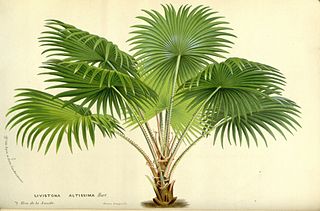
Saribus is a genus of palms, native to Southeast Asia, Papuasia and Pacific Islands. They are fan palms, the leaves with an armed petiole terminating in a rounded, costapalmate fan of numerous leaflets.

Gymnostoma is a genus of about eighteen species of trees and shrubs, constituting one of the four genera of the plant family Casuarinaceae. The species grow naturally in the tropics, including at high altitudes having temperate climates, in forests in the region of the western Pacific ocean and Malesia. In New Caledonia, published botanical science describes eight species found growing naturally, which botanists have not found anywhere else (endemics). Additional species have been found across Burma, Sumatra, Borneo, the Philippines, Sulawesi, Ambon Island, the Moluccas, New Guinea, the Bismarck Archipelago, the Solomon Islands, and one endemic species each in Fiji and the Wet Tropics of Queensland, Australia.

Stigmatodactylus is a genus of flowering plants from the orchid family, Orchidaceae. It has thirteen currently recognized species, native to China, Taiwan, Japan, the Himalayas, the Philippines, Malaysia, Indonesia, New Guinea and the Solomon Islands.















